Introduction
Thermoforming is a manufacturing process that involves heating a thermoplastic sheet until it becomes pliable, stretching it over a mold, and then cooling it to form a solid object with the desired shape. The process is typically categorized into three main types:
- Vacuum Forming: In vacuum forming, the heated plastic sheet is draped over a mold, and a vacuum is applied to draw the sheet tightly against the mold’s contours, creating the desired shape.
- Pressure Forming: Pressure forming is similar to vacuum forming, but it involves the additional application of air pressure to force the heated plastic sheet against the mold, resulting in more precise detailing and sharper definition of features.
- Twin-Sheet Forming: Twin-sheet forming involves heating and formikng two separate plastic sheets simultaneously, which are then joined together to create a hollow, double-walled structure. This method is commonly used for producing items such as storage containers and automotive parts.
The Thermoforming Process
The thermoforming process typically begins with the design of the part to be manufactured. Design considerations such as material selection, part geometry, draft angles, and undercuts play a crucial role in determining the feasibility and success of the thermoforming process.
Once the design is finalized, a thermoplastic sheet of the chosen material is heated to a specific temperature until it reaches its forming temperature, where it becomes pliable and can be easily molded. The heated sheet is then transferred to a forming station, where it is draped over a mold or cavity that defines the shape of the final part.
In vacuum forming, a vacuum is applied to draw the heated sheet tightly against the mold, while in pressure forming, additional air pressure is used to force the sheet against the mold’s contours. Once the forming process is complete, the formed part is cooled to solidify its shape, trimmed to remove excess material, and finished as required.
Materials Used in Thermoforming
A wide range of thermoplastic materials can be used in the thermoforming process, each offering unique properties and characteristics suited to specific applications. Common thermoforming materials include:
- Polystyrene (PS): Known for its clarity, rigidity, and affordability, PS is often used in packaging, disposable cups, and trays.
- Polyethylene (PE): PE is a versatile material with excellent impact resistance and flexibility, making it suitable for applications such as food packaging, automotive components, and recreational equipment.
- Polyvinyl Chloride (PVC): PVC offers good chemical resistance and durability, making it ideal for products such as signage, medical packaging, and consumer goods.
- Polypropylene (PP): PP is lightweight, durable, and heat-resistant, making it suitable for a wide range of applications, including food packaging, automotive parts, and electronic enclosures.
- Acrylonitrile Butadiene Styrene (ABS): ABS combines the strength and rigidity of acrylonitrile and styrene with the toughness of butadiene, making it well-suited for applications requiring impact resistance, such as automotive interior components and consumer electronics.
Applications of Thermoforming
Thermoforming finds applications across a diverse range of industries, including:
- Packaging: Thermoforming is widely used in the packaging industry to produce trays, blister packs, clamshells, and other types of protective packaging for food, electronics, pharmaceuticals, and consumer goods.
- Automotive: Thermoforming is used to manufacture interior and exterior components for automobiles, including dashboards, door panels, bumpers, and trim pieces.
- Medical: Thermoformed medical packaging ensures the sterility and protection of medical devices and pharmaceutical products, while thermoformed equipment housings and components are used in medical devices and diagnostic equipment.
- Consumer Goods: Thermoforming is employed to produce a variety of consumer goods, including toys, appliances, sporting goods, and point-of-purchase displays.
- Industrial: Thermoformed parts are used in industrial applications such as equipment enclosures, machinery housings, and material handling trays.
Advantages of Thermoforming
Thermoforming offers several key advantages over other manufacturing processes, including:
- Cost-Effectiveness: Thermoforming is often more cost-effective than injection molding or other forming processes, particularly for low to medium volume production runs.
- Versatility: Thermoforming can accommodate a wide range of part sizes, shapes, and geometries, making it suitable for producing both simple and complex components.
- Rapid Prototyping: Thermoforming allows for the quick and cost-effective production of prototypes and small-batch runs, enabling faster product development cycles.
- Material Efficiency: Thermoforming produces minimal waste, as excess material can be recycled and reused in the manufacturing process.
- Customization: Thermoforming offers opportunities for customization through the selection of materials, colors, textures, and finishes, allowing for the creation of unique and visually appealing products.
Conclusion
Thermoforming is a versatile and cost-effective manufacturing process that offers numerous advantages for the production of a wide range of products across industries. By understanding the principles, processes, materials, applications, and advantages of thermoforming, manufacturers can leverage this technology to create innovative and high-quality products that meet the needs of today’s marketplace.
Whether you’re a seasoned industry professional or someone new to the world of manufacturing, exploring the possibilities of thermoforming opens up a world of opportunities for creativity, efficiency, and success.

